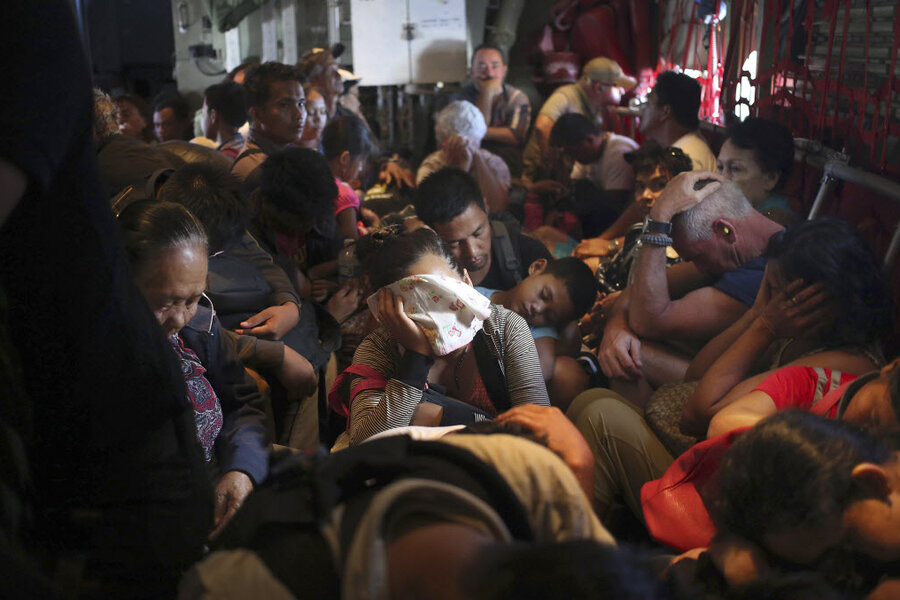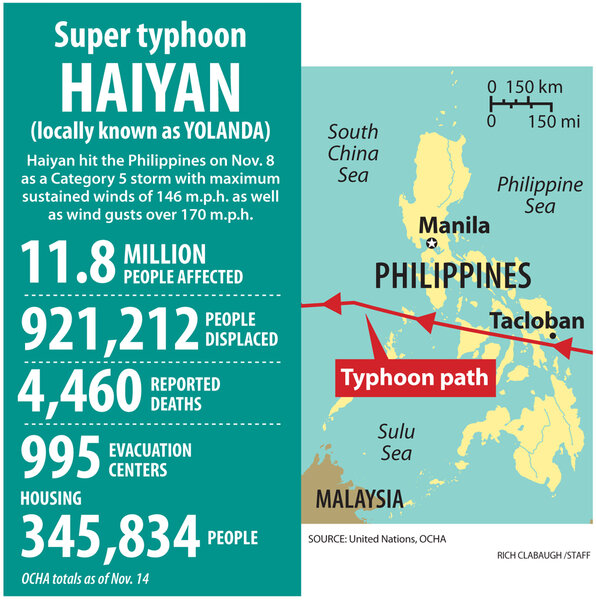Filipinos reach out to typhoon evacuees as US relief effort moves into high gear
Loading...
| Tacloban and Manila, Philippines
On the wide steps of a stadium in Manila that until recently hosted Philippine military parades, evacuees from the devastated city of Tacloban lay blankets on flattened cardboard boxes that offer some measure of cushioning from the concrete.
The evacuees arrive day and night, streaming out of US military supply planes that leave this base filled with food and water and return with residents of eastern cities destroyed by typhoon Haiyan, one of the worst storms ever to hit land.
They have left a city destroyed, piling into jump seats and spreading out on the floors of the cavernous plane, straining with the takeoff to catch glimpses of their hometown through the small windows. For many, it is their first flight. Once airborne, they try to rest, what for many is the first sleep they have had in days.
As she stands in the stadium, Joanna Abanes cradles her one-month-old daughter and recalls what it was like as the storm hit. The waters continued to rise with each passing hour, she says, as the family made its way to the second floor of their house.
“We climbed up as high as we could,” she recounts, and still the water came flooding upward. “It was so scary.”
Today, she is waiting here to be reunited with the rest of her family members, who survived but have not yet been evacuated.
“Now we don’t have a house. But it’s OK," she says, rocking her daughter. “My baby is here.”
Here at Villamor Air Base, a Philippine military installation that US forces are also using as a staging area for the relief effort, she is given a supply of diapers and supplemental infant formula. She is also approached by a volunteer lactation specialist from Manila, who encourages her to seek help if she has any trouble breast-feeding, which can happen, the specialist tells her, during times of trauma.
Indeed, the grounds around the stadium are teeming with residents of Manila who have come to offer help in the aftermath of Haiyan, whose death toll currently stands at nearly 4,000. Some 10 million people have been displaced or otherwise affected by the storm, according to US military estimates.
At one aid station, evacuees learn from brightly-colored posters that life coaching is available. At another, acupuncturists are volunteering their services in hopes of providing “stress relief” for survivors of the storm.
“We just want to help," says one, "to do whatever we can for our fellow human beings.”
This base, which it connected to Manila International Airport, is the hub of a major relief effort. “The speed of the military response is unprecedented – and the scale of the military response is unprecedented,” says Marine Brig. Gen. Paul Kennedy, who commands the 3rd Marine Expeditionary Brigade.
The US military began arriving on the ground within 12 hours of the storm, and has logged roughly 500 flight hours and, under the direction of the US Agency for International Development (USAID) moving nearly 1,200 relief workers into Tacloban and airlifting out nearly 2,900 displaced people.
A contingent of more than 600 US military personnel is on the ground in The Philippines now, with an additional 1,000 Marines and sailors arriving in the next couple of days.
"As of yesterday, there were 16 countries flying aircraft into Tacloban alone,” says Col. John Peck, chief of staff for the 3rd Marine Expeditionary Brigade. “That gives you a sense of the traffic.”
President Benigno Aquino III, who has come under attack for what many charge was a slow emergency response, today toured Tacloban, in a visit aimed at improving the flow of aid but which also temporarily shut down flights into the city of 220,000, much to the consternation of the US military. President Aquino has vowed to stay in the area, where electricity and water are still in short supply, until he sees more progress.
For now, Tacloban appears to have been reclaimed to a great degree by the seas, courtesy of a 20-ft.-high storm surge by a harbor whose shape acted as a funnel of sorts, officials say. That made for the worst possible combination: a tsunami coupled with a typhoon packing winds that topped 190 m.p.h., notes the US military's Kennedy. US troops here liken that sort of force to standing behind the turbine engine of one of the powerful planes that now dot the runways in Tacloban.
Trees that remain standing are barren skeletons stripped of their foliage. Even the flexible palm trees are uprooted, blocking roads and blown into homes.
The work of clearing the scarred landscape continues into the dark, the headlights of bulldozers the only light on the runway as residents wait in orderly lines for evacuation, holding what little they were able to salvage from their homes.
The US military, directed by USAID, has been supplying food and water, as well as fuel, which is high demand. The military discovered that Tacloban’s water purification plant was actually largely intact, but it needed fuel in order to run.
The Philippine government has also been requesting fuel for generators, vehicles, and road clearing.
“Every tree is down,” says Col. Peck. “It literally just destroyed everything along a wide path.”
Peck recalls flying over areas of Japan in 2011 hit hardest by the tsunami that killed 19,000 people. At the time, he was commander of a squadron of C-130 cargo planes that were assisting in the relief effort.
“In terms of the depth of destruction, to me, it’s comparable,” Peck says. “Any structure that wasn’t made of concrete or steel is flattened, and that’s why the road systems have been so difficult to open. It’s not just a matter of picking up a few trees here and there.”








